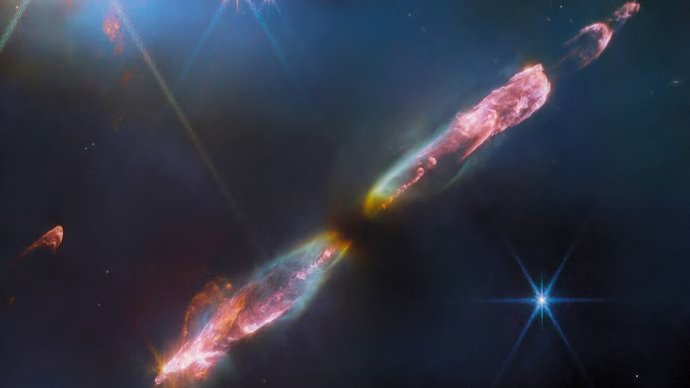By – Prakarsh Kastwar
The unusual image shows supersonic jets of star stuff erupting from a young star’s poles and whizzing through space.
The most powerful telescope ever created by humans, the James Webb Space Telescope (JWST), has photographed a newborn star’s supersonic exhaust, which provides a glimpse of what our Sun may have looked like many thousands of years ago. The unusual image shows supersonic jets of star stuff erupting from a young star’s poles and whizzing through space.
The brilliant areas surrounding young stars visible in the photograph are known as Herbig-Haro objects. Herbig-Haro (HH) 211 is the name of the particular Herbig-Haro object, which is situated roughly 1,000 light-years from Earth in the constellation Perseus.
If we could capture a baby picture of our Sun, it might resemble this, NASA stated in a post with the image. This @NASAWebb image shows a young star with gas jets shooting out of its poles at supersonic speeds. Although it is only a few tens of thousands of years old, this star will resemble our Sun when it matures.
https://www.instagram.com/p/CxLMG7GOn2u/?utm_source=ig_web_copy_link&igshid=MzRlODBiNWFlZA==
”Formed when stellar winds or jets of gas erupting from these newborn stars generate shock waves impacting with surrounding gas and dust at high speeds,” NASA noted. A Class 0 protostar, the young star is only a few tens of thousands of years old and has a mass of only about 8% that of the sun. It is anticipated that it will eventually develop into a star similar to the sun.
Webb can visualize the structure of the outflows thanks to the infrared light given off by excited molecules such as molecular hydrogen, carbon monoxide, and silicon monoxide. The recently revealed photograph, which has an image resolution that is between 5 and 10 times higher than any prior image of HH 211, reveals the newborn star’s surroundings in unparalleled detail.
“Earlier observations of HH 211 with ground-based telescopes revealed giant bow shocks moving north-west and south-east, cavity-like structures in shocked hydrogen and carbon monoxide, as well as a knotty and wiggling bipolar jet in silicon monoxide. According to Webb’s recent measurements, the object’s outflow is rather slow when compared to outflows from more developed protostars, according to NASA.
The 2021-launched and 2022-started Webb telescope has revolutionized knowledge of the early universe while producing breathtaking images of the cosmos. Since it started operating, Webb has produced a flood of previously unheard-of data, showed the existence of the oldest known galaxies, and black holes. The Hubble telescope is nearly 100 times less powerful than Webb.

